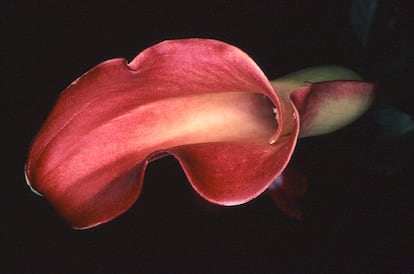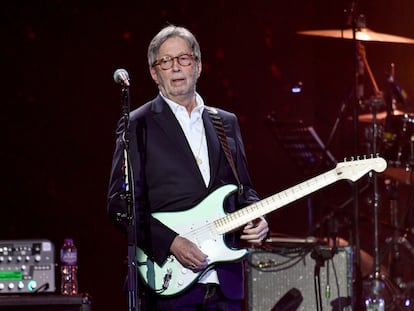The flowers that smell of sex and death
Vicente Todolí, former director of the Tate Modern, has curated a series of photographs on the plant world for a new exhibition in Madrid

Nabuyoshi Araki once said “flowers smell of death,” but also of sex. As such, they permeate the imagination of the Japanese photographer like symbols of Eros and Thanatos. Death and desire always travel hand in hand for this controversial artist, who grew up in the shadow of the Jyokanji temple, where the victims of the 1913 great fire of Yoshiwara – old Tokyo’s red-light district – lie, in the cradle of Edo culture. As a child, Araki liked to observe the flowers that visitors left on the graves. “The flowers become enriched with life as they approach death,” he wrote in Kakyoku, a monograph dedicated to his floral work. “Their moment of splendor comes just before they perish. When one approaches them, one is enraptured with a sexual spirituality. I can hear a Rondeau.”
Flower Rondeau is the name of one of the photographer’s series of floral works. A hymn to life and death composed of 119 exuberant close-ups, taken between 1997 and 2016, where the first stages of decline and the fragility of various varieties of flowers can be appreciated in their full brilliance. Sumptuous and audacious colors lie in contrast to a dark background where petals, sepals, stigmas and stamens create a “floral sex scene,” in Araki’s words. The collection can be seen at Botánicas, an exhibition at the Pabellón Villanueva at Madrid’s Royal Botanical Gardens that brings together a group of works belonging to the Per Amor a l’Art foundation. “An herbarium of artists,” as described by Vicente Todolí, curator of the exhibition and former director of the Tate Modern. In the exhibition, which can be seen until March 20, 14 artists present stories that give shape to the reality of flowers and plants.
“Art and nature, a perfect symbiosis that offers the visitors the opportunity to immerse themselves in the history of photography through botany, and vice versa,” says Todolí. The relationship between the two disciplines dates back to the origins of the photographic medium, when pioneers of photography and botany such as William Henry Fox Talbot and Anna Atkins, brought the fertile association to the wider public.

The exhibition takes in a century of photography beginning with the microphotography of Karl Blossfeldt, the German sculptor, teacher and nature enthusiast who, without intending to, through his sober esthetic and poetic refinement, freed photography from its servitude as a mere document. His detailed close-ups, which lay bare the architecture of plants, were designed to serve as a reference point for his students in their work with cast-iron ornamental pieces. Blossfeldt would go on to become a leading figure in the New Objectivity movement that arose in the 1920s, and among whose ranks was Albert Renger-Patzsch, another key proponent of the trend. Through the use of dark, neutral or unfocused backgrounds, Renger-Patzsch’s plant images offer detailed shots that show the point of view of his compatriot and predecessor and the influence of his illustrations on the field of science.
The view of the plant world that Imogen Cunningham offers us exudes sensuality and subtlety. Based on the celebration of form promulgated by the modernist movement, her flowers are understood as esthetic compositions. Plants became the favorite subject of the photographer when her children were growing up and they display a greater erotic charge than her nudes, which undoubtedly went on to inspire the plant work of American photographer Robert Mapplethorpe.
The works in the exhibition are presented in series, different stories that reflect different esthetic approaches and particular universes. “As Olivier Lugon stated, ‘for advocates of the documentary style, photographic art is not considered as a shot, but more of a construction, carried out in stages and resulting both from the projection and re-evaluation of images, as well as from their creation,” writes Nuria Enguita in the catalog that accompanies the exhibition. As such, Pierre Verger’s love of travel and anthropology transports us to an exotic, mystical and unexplored world of suggestive forms in black and white. From there, the baton is taken up by Juan del Junco, whose procedure with landscape contrasts with the fidelity of the discoverers and classifiers of species.
The vast and colorful floral studio portraits of Hans-Peter Feldmann are framed within a kitsch sensibility designed to seduce as much as to repel. The German artist works with appropriated photographs to which he gives new life. “He observes plants through the exaggerated exposure of their visual impact,” notes Carles Ángel Saurí in the catalog. To the extent that the plant motif triggers in the viewer “a desire that ends up turning them into beings manipulated by the esthetic impact of the work.” Both the frontal composition and the objective narrative conspire to make the viewer question whether the flowers are organic or a plastic copy. Part of Feldmann’s series was displayed at the Münster Sculpture Project in 2007, where he had the public bathrooms on the Domplatz square remodeled with the introduction of his floral motifs, in line with Carl André’s dictum that a society that does not provide its citizens with public conveniences is unworthy of public art.
The collages of Alesandra Spranzi stand out, the artist’s empty flowers contrasting with the hegemonic floral representations. Jonas Mekas and Jochen Lemper remind us that nature cannot be captured in a single image. “It cannot be static, for science or for art,” says Enguita. As such, in its purpose of pausing time and allowing that which passes unnoticed to become visible, photography takes us deeper into mystery. By inviting us to see, it inevitably entices us to imagine.
Tu suscripción se está usando en otro dispositivo
¿Quieres añadir otro usuario a tu suscripción?
Si continúas leyendo en este dispositivo, no se podrá leer en el otro.
FlechaTu suscripción se está usando en otro dispositivo y solo puedes acceder a EL PAÍS desde un dispositivo a la vez.
Si quieres compartir tu cuenta, cambia tu suscripción a la modalidad Premium, así podrás añadir otro usuario. Cada uno accederá con su propia cuenta de email, lo que os permitirá personalizar vuestra experiencia en EL PAÍS.
¿Tienes una suscripción de empresa? Accede aquí para contratar más cuentas.
En el caso de no saber quién está usando tu cuenta, te recomendamos cambiar tu contraseña aquí.
Si decides continuar compartiendo tu cuenta, este mensaje se mostrará en tu dispositivo y en el de la otra persona que está usando tu cuenta de forma indefinida, afectando a tu experiencia de lectura. Puedes consultar aquí los términos y condiciones de la suscripción digital.
More information
Archived In
Últimas noticias
Maduro pleads not guilty before the federal court in New York: ‘I am still the president of Venezuela’
A new test can detect Alzheimer’s from a finger prick
UN team enters Sudanese city of El Fasher after paramilitary massacre: ‘It’s like a ghost town’
A recipe for resistance: Indigenous peoples politicize their struggles from the kitchen
Most viewed
- Gilles Lipovetsky: ‘If you want to live better and fall in love, take Prozac, don’t look to philosophy’
- Alain Aspect, Nobel laureate in physics: ‘Einstein was so smart that he would have had to recognize quantum entanglement’
- Alvin Hellerstein, a 92-year-old judge appointed by Bill Clinton, to preside over Maduro’s trial in New York
- Why oil has been at the center of Venezuela-US conflicts for decades
- Maduro’s downfall puts China’s relationship with Venezuela to the test











































